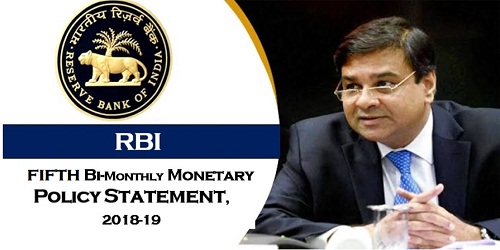On December 5, 2018, RBI released its 5th Bi-monthly monetary policy produced by the Monetary Policy Committee chaired by RBI Governor Dr. Urjit Patel.
 The 6th and last meeting of the Monetary Policy Committee is scheduled to be held from February 5 to 7, 2019.
The 6th and last meeting of the Monetary Policy Committee is scheduled to be held from February 5 to 7, 2019.
| Policy Rates | |
| Repo Rate | 6.5% |
| Reverse Repo rate | 6.25% |
| Marginal Standing Facility (MSF) rate | 6.75% |
| Bank Rate | 6.75% |
| Reserve Ratios | |
| CRR | 4% |
| SLR | 19.5% |
| GDP Prediction | |
| For 2018-19 | 7.4% |
| For 2018-19 H2 | 7.2-7.3% |
| For 2019-20 H1 | 7.5% |
| CPI Inflation | |
| For 2018-19 H2 | 2.7-3.2% |
| For 2019-20 H1 | 3.8-4.2% |
Following are the key points inferred from the policy:
i. The global economic activity has shown increasing signs of weakness on rising trade tensions especially among the advanced countries like US and European countries.
ii. The prices of oil and base metal has reduced which is bringing about geo-political ease.
iii. Gold prices have however risen though a strong dollar may stem the rise.
iv. Inflation scenario is the same in the US and Euro regions however the emerging economies (EMEs) inflation has risen, though the recent retreat in energy prices, tightening of policy stances by central banks and stabilising of currencies may have a beneficial impact in near future.
v. GDP of India has slowed down to 7.1% in the 2nd quarter of 2018-19 after four consecutive quarters of acceleration.
The reasons for this decline are:
- Decline in rural demand, subdued growth in kharif output, depressed prices of agricultural commodities and sluggish growth in rural wages, which resulted in low private consumption and
- Growth of imports accelerated at a much faster pace than that of exports, resulting in net exports pulling down aggregate demand.
vi. However, the growth in Government final consumption expenditure (GFCE) strengthened, due to high expenditure of the government in national projects.
Gross fixed capital formation (GFCF) expanded mainly by the public sector’s thrust on national highways and rural infrastructure, which was also reflected in robust growth in cement production and steel consumption.
vii. On the supply side, growth of gross value added (GVA) at basic prices decelerated to 6.9 per cent in Q2 reflecting the slow growth of the agricultural and industrial activities.
- In the Agricultural front: This was due to stunted growth in kharif production.
- In the Industrial front: Growth in manufacturing decelerated due to lower profitability of manufacturing firms, pulled down largely by a rise in input costs.
- Also there has been decelerated growth in the mining sector due to low output of crude oil and natural gas.
- In the Services sector: Growth remained unchanged compared to the previous quarters.
- In the Construction sector: There has been significant decline in growth.
- In other sectors: Growth in public administration and defence services accelerated sharply and Growth in electricity, gas, water supply and other utility services strengthened.
viii. Growth in the index of industrial production (IIP) slowed down to 4.5 per cent in September 2018.
The growth in core industries recovered in October on the back of double-digit expansion in coal, cement and electricity.
The purchasing managers’ index (PMI) for manufacturing touched an eleven-month high of 54.0 in November, supported by an expansion in output, and domestic and export orders.
ix. According to the assessment of the Reserve Bank’s Industrial Outlook Survey (IOS), the overall business sentiment in Q3 remained stable, with sustained optimism about production and exports.
x. Retail inflation, measured by y-o-y change in CPI, declined from 3.7 per cent in September to 3.3 per cent in October.
Adjusting for the estimated impact of an increase in house rent allowance (HRA) for central government employees, headline inflation was 3.1 per cent in October.
xi. There was large currency expansion in October and especially during the festive season in November. Currency in circulation, however, contracted in each of the last three weeks in November.
Due to the liquidity crunch, the Reserve Bank injected durable liquidity amounting to Rs.360 billion in October and Rs.500 billion in November through open market purchase operations, bringing total durable liquidity injection to Rs.1.36 trillion for 2018-19.
Liquidity injected under the LAF, on an average daily net basis, was Rs.560 billion in October, Rs.806 billion in November and Rs.105 billion in December (up to December 4).For more information: Click Here
Other News:
- In order to bring about consumer confidence in the digital financial transaction channel, RBI issued ‘Statement on Developmental and Regulatory Policies’ report.
- This states the establishment of ‘Ombudsman Scheme for Digital Transactions’ which will act as a dedicated, cost-free grievance redressal mechanism. This will handle customer complaints related to digital transactions.
- Further notification of the scheme will be issued by the end of January 2019.
- RBI will reduce the SLR by 0.25% every Quarter beginning January 2019,till it reaches 18%.
RBI:
♦ Founded: 1st April 1935.
♦ Headquarters: Mumbai.
♦ 24th Governor: Dr. Urjit Patel.




